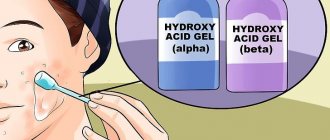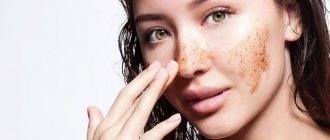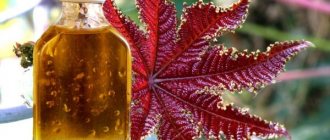Dyeing your hair yourself is not a problem for many women. If you just need to touch up the roots or update the color, then coping with this task at home is not so difficult. However, most women have difficulty with how and with what to wipe off traces of hair dye on the skin. After all, you really want to look beautiful immediately after coloring! And the marks ruin everything. The means at hand will help you get rid of them: from alcohol to kefir. Read on for detailed instructions.
Traditional methods
As a rule, professional hairdressers and stylists prefer to remove the product immediately during the coating process. If you don't miss the time, you can wipe off the composition with a cotton swab and warm water.
Otherwise, the stain may dry out, and its removal will take much longer and will require the use of special products or traditional recipes.
Baking soda is considered a simple, cheap and affordable remedy, which can always be found in the house. Therefore, even if coloring is done at home, the skin problem can be easily solved.
Mix two teaspoons of baking soda with warm water to form a thick paste and leave for 2 minutes. The composition is applied to contaminated areas of the face, gently massaging them. After a few minutes, the soda is washed off with warm running water.
In this way, you can also remove stains from the fingers and nails left from exposure to the dye. A heavily soiled nail can be rubbed with a mixture of baking soda and liquid dishwashing detergent.
Those with sensitive skin prone to allergic reactions are not recommended to use baking soda to get rid of paint stains, as it softens the epidermis and can cause irritation after the procedure.
Oil
The use of natural vegetable oil is considered a gentle and safe method. It has a softening effect, opens pores and removes stains.
Unrefined oil is thickly applied to a cotton swab and massaged into the contaminated area. Leave the product on the skin for an hour, then remove the residue with a soft cloth and wash off with warm water and soap. You can replace the oil with cold-pressed raw materials.
An ancient way to clean fabrics and hard surfaces from deep stains is to use ash or ash. They are able to remove and clean even the most difficult stains. For this purpose, you can use ash from cigarettes or burnt paper.
A cotton pad is moistened with water and sprinkled with ash. Apply it to dirty places and rub it. After a 3-minute exposure, rinse everything off with clean water. Wood ash is also suitable for such purposes.
Vinegar
Vinegar quickly removes color stains. For application to the skin, it is recommended to use malic or tartaric acid, as table vinegar can cause burns on the face or neck.
The substance is heated to a warm state in a water bath. Soak a cotton swab in it and apply lotions to the contaminated area for a couple of minutes. It is recommended to wash off the vinegar with warm water and detergent.
This method is well suited for effectively erasing dark spots near the hairline or from the scalp.
Kefir
Kefir is considered a safe ingredient in masks and homemade hair balms. It effectively removes color residue from the face, neck and hands.
Undiluted kefir is applied to the spots and the skin around them. Leave the dairy product on the epidermis for 15 minutes, then wash off with water.
Severe and deep stains are treated with a cotton swab soaked in it and wiped off after 30 minutes.
You can wash off the color from heavily soiled hands using baths. They are kept in the milk product for about a quarter of an hour, after which they are washed off with warm water.
Toothpaste
Dental and oral care products are not intended for use on the face or specific areas of the body. Use the paste to remove paint from acrylic bathtubs and sinks and whiten teeth. But in the absence of other means, it can also cleanse the skin of pigment residues.
Apply a thin layer of paste to the stain and leave until dry. Then rinse it thoroughly with water. Clean the area with moisturizer.
Lemon
Lemon juice has excellent properties, so this citrus fruit is actively used to wash off hair dye residues.
Rub a slice of lemon onto the stain with light movements and leave for a few minutes. Then the acid is washed off with warm water and treated with a moisturizer.
You can also use a cotton swab dipped in fruit juice. Lemon for facial cleansing should only be used by those who do not have an allergic reaction to citrus fruits.
How to wash off paint
You can choose many methods that allow you to quickly wash off the pigment without harming the skin.
Store formulations
Salons and stores offer professional cosmetics that remove dyes from the scalp.
This includes the following products:
- Igora Color;
- remover;
- Dixon Remover.
We offer high quality products that save a lot of time. There is a cheaper Curl product designed for perm. It also removes dyes.
Shampoos and conditioners
After dyeing, use regular shampoos, balms, and soap solutions to remove the chemical component. The products are diluted with water, and then the stain is wiped. Elimination is possible if the pigment has not penetrated deeply.
If the shampoo does not help, use various chemicals, and then re-wipe the skin with shampoo and conditioner.
A good effect is achieved by washing the scalp and hair 2-3 times, thoroughly rubbing the surface with massaging movements.
Use of professional products
Manufacturers of branded hair dye brands produce special skin cleansers. They are usually used by stylists in professional salons to safely remove stains.
Remover from Estelle
Estel offers a lotion for removing paint from skin, Estel Skin Color Remover. The advantages of this tool include:
- ammonia-free composition;
- neutral pH level;
- no drying effect on the skin;
- easy application and quick effect.
The cost of such a composition is also quite affordable. In professional salons it can be purchased at a price of 250 to 300 rubles per unit.
See also: how to clean your hands of any paint (video)
Remover from Londa
The well-known brand Londa offers its users a product for removing paint stains, Londa Stain Remover. It is preferred to be used by those people who have a history of allergic reactions to artificial dyes, because:
- the composition does not cause side effects in the body and allergies;
- acts quickly and effectively, does not require prolonged contact with the skin;
- economical to use.
You can buy it for 350-400 rubles.
Remover from Schwarzkopf Professional
The well-known manufacturer of professional cosmetics, Schwarzkopf Professional, recommends washing off paint residues using Igora Remover. It belongs to safe compounds.
The castor oil it contains saturates the skin with nutrients and essential vitamins. This product does not contain ammonia or other irritants. The cost of this product ranges from 400 to 450 rubles per unit of goods.
Before using any of the professional removers, you should make sure that there is no allergic reaction to it. A few drops are applied to the back of the hand and left for 3-15 minutes. If redness does not appear on the body, then the product can be used.
Hair
Drops of paint may fall on your head during finishing work. Oil paint is not dangerous until it dries. One of the effective methods of cleaning hair is the use of vegetable oil. It should be applied to dirty hair, left for 15 minutes, and then removed with a damp cotton pad. After the procedure, rinse your hair with shampoo twice and apply a mask or balm.
Water-based emulsion and other water-based materials can be washed off with regular shampoo. Wash your hair with warm water and massage your scalp. After the first wash, remove any softened pieces of paint. Then wash your hair again and apply a nourishing mask. If you feel that particles of material remain on your hair, use baby or vegetable oil.
Before you start painting furniture, walls and other surfaces, take precautions. Wear protective clothing, rubber gloves and a hat. Long hair should be tied in a ponytail or bun, with a scarf tied on top. Cover the floor and furniture with newspapers. If you follow all of these tips, you won't have to worry about how to remove paint from your body, clothes, or furniture.
How to prevent stains after dyeing
Precautionary measures taken immediately before the coloring procedure will help protect the skin of the neck and face from unwanted stains.
Front zone protection
To prevent tinting of the line near the hair, when applying paint to them, it is recommended to follow the following rules:
- The coloring procedure should be carried out no earlier than 24 hours after the last hair wash. Natural sebum will serve as a repulsive factor for color penetration.
- Apply thick cream or Vaseline in a 1-2 cm strip along the hairline and on both ears.
After the procedure, it is recommended to thoroughly wash the treated area to remove any greasy marks.
Additional protections
In addition to protecting your hairline, you should also take care not to stain your arms, décolleté and neck.
Protect your hands with special gloves, which usually come in the package with the product. The neck and décolleté area are covered with natural cotton fabrics. You can use adhesive tape to secure it. If dye accidentally gets on your skin, you should immediately wipe it off with a cotton swab moistened with alcohol.
On the first day after the procedure, it is advisable to collect your hair in a bun and avoid moisture. Otherwise, color remnants may appear even after rinsing.
Which paints are easier to clean?
All hair coloring products can be divided into three groups:
- Natural. These products include henna, basma, and plant extracts. When using them, you will not be able to achieve sudden changes in your image. Natural dyes saturate the natural hair color, making it brighter and deeper.
- Physical. These include tinted shampoos, balms, gels and tonics. Tinting shows short-term results. Just 5-6 washes with regular shampoo, and your hair will return to its natural color.
- Chemical. These products include cream paints, mousses and gels. They are created for dramatic changes. Penetrating into the structure of the hair, chemical components change the pigment, helping women cover gray hair without a trace or, conversely, turn into an ash blonde, being the mistress of lush dark hair.
The depth of penetration of the dye into the hair structure depends on the naturalness of the components of the coloring agents. The dye is equally dangerous for hands and other areas of the skin. Natural henna can leave behind a difficult-to-remove streak on the forehead along the hairline. It is very difficult to wash off paint, even if it belongs to the group of tint products. It doesn’t matter whether a stain appeared on the skin when using a natural dye or paint with ammonia, the same products will help in the fight against it.
Reviews
To have an idea of the effectiveness of a professional or folk remedy, it is worth studying real reviews about their use.
A little about removers
Estel Skin Color Remover is what I have been looking for for a long time. For me, the product is perfect: safe and fast, instantly removes blemishes from the skin. One bottle lasts a long time, I use a little at a time.
I use Igor Remover from Schwarzkopf. This lotion can erase even the most difficult stains, including those on the hands and neck. Everything happens very quickly, after one simple processing. I always keep it at hand and quickly remove all drops of paint before washing off my hair.
Let's talk about folk remedies
I have allergy-prone skin, so I’m wary of using removers to remove paint stains. I wipe my face and ears with regular soda - cheap and effective. I have to devote a little time, of course, but I am satisfied with the result.
Alevtina, 40 years old
I have a problem: I can’t carefully apply dye to my hair, I’ll smear everything: my arms and my neck. I wash myself only with kefir. It's safe and even useful. Of course, you have to tinker, but this dairy product washes off flawlessly.
I try to get rid of unwanted stains after dyeing using folk remedies. I use lemon, which also removes pigmentation. If you get carried away and rub harder, the skin, of course, turns red and burns. So moderation is important in everything. And so everything works out and the juice from the fruit works quite well.
We save clothes
Clothes are the first to get dirty. Do not rush to throw away “stained” things or send them to the dacha to serve as a robe. You can remove stains even from thin, delicate fabrics if you follow the following rules:
- Fresh paint comes off easier than dried paint. Don't hesitate to wash, no matter what kind of stain it is.
- The denser the material, the less likely it is to damage the fabric during cleaning.
- Do not use reagents (solvents or acids) without first testing and reading product labels.
Fresh oil paint can be removed using acetone (nail polish remover), lighter fluid, or turpentine. Turn the product inside out and place three layers of paper napkins under the stain. Treat the stain with a cotton pad soaked in solvent, moving from the edges to the center. When working with delicate fabrics, replace the solvent with warmed glycerin. Old dried stains can be wiped off with white spirit.
You can wash water-based paint before it dries with plain warm water and laundry soap. If the stain has dried, the material needs to be soaked. To do this, place a sponge soaked in water on the contaminated area for half an hour. For best results, use Antipyatin soap or stain remover. Acrylic paint can be easily removed with isopropyl alcohol.
The task becomes more complicated if hair dye (especially with a dark pigment) gets on your clothes. If this happens before your eyes, immediately remove the item and place the stain under warm running water. If the dye has penetrated into the fibers of the fabric, use 3% hydrogen peroxide.
How to prepare for painting without getting dirty
When starting the hair coloring procedure, you should take measures to ensure that your clothes and skin are not stained with dye. Do not neglect the rules for conducting operations with:
- protecting your hands with special gloves that come in a box with dye;
- wrapping the neck with film or waterproof cloth;
- lubricating the forehead, ears with Vaseline or baby cream;
- using a special brush for painting.
It is advisable that someone help carry out the procedure, otherwise it is difficult to dye your hair efficiently on your own. And with an assistant, painting can be done without staining your skin or clothes.
How to remove
Even small paint stains on the skin can lead to irritation and itching if the product contains active chemicals. Henna and basma are safer, but they leave streaks on the skin that don’t wash off for a long time. You need to immediately wipe off the drops from your face and neck. Then they can become so embedded in the pores of the epidermis that you will have to walk for a long time with your face or ears dirty. It is necessary to choose an effective remedy from the substances that every housewife has in her kitchen.
Tonics are easy to clean, but stubborn types of dyes can only be removed with professional cleansing.
Why is it difficult to cleanse your skin after dyeing your hair?
The durability and color of the paint affects the corrosiveness of the marks: dark and bright colors are more noticeable on the skin and nails, and light colors are less noticeable. As for durability, everything is clear here. Regardless of how your dye acts - it envelops the hair (unstable, tinting) or penetrates its structure (persistent) - the stains from it eat into the stratum corneum of cells in the same way. Moreover, even from a tint balm, traces that are not removed in time will remain on the skin for several more days. So if paint gets on your body, you need to act immediately.
You need to remove stains from any type of hair dye as soon as possible.
Traditional methods
It is better to remove stains on the forehead and temples from coloring using methods that have been tried by many women at home. Once you have chosen the appropriate method for removing hair dye from your skin, you can use it continuously.
Laundry soap
Fresh stains can be successfully scrubbed off with warm water in which shavings of laundry soap are dissolved. Soak a cotton pad in a soap solution and wash off the dirt. But do not forget that soap contains alkali, which dries out the body. Therefore, if the skin is prone to irritation, the product should not be used.
Alcohol lotion
Remove paint from the face, neck, and hands with a cotton pad soaked in alcohol or vodka. But it is better to replace drinks with special lotions made with alcohol. The cosmetic product is able to dissolve chemicals and has a gentle effect on the skin while cleansing it.
Peeling agent or scrub
It is recommended to use scrubs prepared by yourself to cleanse the epidermis. They can be based on salt or sugar, ground coffee. It is necessary to mix the abrasive substance with oatmeal, corn oil and sour cream. The mass is applied to the problem area, rubbing in a circular motion. Then wash off with warm water, followed by applying a nourishing cream.
Makeup remover
You can clean areas stained with paint using makeup remover. They act delicately, softly. Their ingredients can remove blemishes to leave your skin clean and healthy. It is best to use the emulsion immediately after coloring your hair.
Toothpaste
For cleaning, use a paste with a whitening effect. Apply it with a brush to contaminated areas. After a few minutes, wash off. This method should not be used by girls with dark complexions. The method is dangerous for those who have delicate skin prone to irritation.
Shampoo
After dyeing your hair, wash your head several times with shampoo. You can dissolve a small amount of detergent in water, and then wash the skin around your head with a cotton pad soaked in foam. It is worth choosing shampoos with natural herbs.
Baking soda can cope with color when areas of the face and neck are stained with it. Dilute the powder with warm water to make a paste. The composition is applied to the dirt. It is necessary to lightly massage the area for the baking soda to work more effectively. Then wash your face, rinsing with water. After wiping, apply nourishing cream. You need to know that the method is not suitable for women with sensitive skin.
Lemon juice or acid
You can wash off hair dye by wiping the problem areas with a slice of lemon. It is known that this method is good for whitening the face and hands. Therefore, the acid of citrus fruit will cope with pollution.
A solution of citric acid is also used for rubbing, which leads to cleansing of the skin.
Peroxide
To avoid burning the epidermis, dilute peroxide with water in a 1:1 ratio. Use a cotton pad or sponge to rub over areas contaminated with paint. It is necessary to apply the product several times, changing napkins.
Vegetable oil
It is recommended to fight old stains with vegetable oil. Even complex stains are completely cleaned. The good thing about this method is that it has a positive effect on the condition of the skin, does not dry out or irritate.
Vinegar
Hot vinegar is required to completely remove paint. But they take either wine or apple. It is heated in a water bath. After cooling slightly, moisten a cotton pad, wiping the paint strips, trying to avoid getting into the eyes. Old stains are removed with acid lotions. After the procedure, do not forget to wash the skin with warm water and soap, and then lubricate it with a nourishing cream.
Wet wipes
Using sanitary napkins, you can easily wash your face and neck from tonic and henna. Immediately after dyeing the hair, thoroughly wipe the stained areas with damp wipes.
Hair fixation spray
You can effectively scrub away bright spots on the skin with a product such as hairspray or Curl curling product. Spray onto a piece of cotton wool or a swab and rub over the stains. The skin remains clean.
But you need to know that coloring must be carried out according to the rules, then there will be less dirt, and they will be easily wiped off.
Dish detergent
Instead of soap, pour a little liquid used for washing dishes into warm water. If the product is inexpensive, without aggressive components, then you can drop it onto a sponge and wipe the skin over your forehead, behind your ears, and neck.
Ash
Ash from burning paper, but not newspapers, or cigarette ashes are poured onto a wet disk. Rub your hands or forehead thoroughly. On delicate areas of the face, rub gently, avoiding redness and irritation.
Petrolatum
The peculiarity of Vaseline is that it absorbs color well. Apply the cream liberally to the face and massage the skin with your fingers. As soon as the mass becomes colored, it is removed and the operation is repeated until the Vaseline remains clear.
Kefir
Another interesting way of cleansing is with kefir. The acidic environment of the product will dissolve the particles of the coloring chemical. Apply fermented milk drink to the stains, leaving for 15 minutes, if the paint has dried - 30 minutes. Then wash off the kefir with warm water.
How to get rid of old paint on metal and other surfaces?
As for the surface of the car, here the task becomes more complicated. It is necessary to remove one paint from another, and so that the original layer is not damaged. In such cases, use a special paint remover that is dissolved in water. Before starting work, it is better to test the resulting mixture on the inside of the body, where an unsuccessfully chosen ratio of water and solvent will not be noticeable if something happens. To do this, treat a small area of paint with the solution and wait 5-7 minutes. If the top layer of paint has not dissolved, you can safely begin working with the dirt.
The rule also applies here: the faster the cleaning is done, the easier it will be to wipe off the layer of excess paint. To work, you need to take a soft cloth that will not scratch the surface of the body. When scrubbing, do not use too much force so as not to deform the car. If the dirt cannot be washed off manually, abrasive polishing of the body can help. It will surely remove all marks and stains. But after carrying out such a procedure, it is better to cover the treated surface with a layer of protective varnish, since it will suffer during polishing.
Varnish not only gives the car shine, but also protects the body from the negative effects of environmental factors, so its absence can become a serious gap in protection. Removing paint from a car is a very delicate procedure, so if you have the money, it is better to entrust it to professionals. They have enough experience and the entire set of necessary tools to make the entire process successful. Craftsmen can also carry out post-processing of the cleaned surface upon the client’s request.
Sometimes the question arises of how to clean old paint before painting again. This is the simplest case of all possible. If the old layer has come off and peels off well, it can be removed with a spatula or other thin tools. Otherwise, you just need to treat the entire surface with a solvent, and then remove the softened layer with the same spatula. Complete removal of old paint allows you to not worry about preserving the bottom layer, which greatly simplifies the procedure.
- light it, the solvent should burn out quickly
“DY Today at 15:19 Did you like the answer and then get a burn?)))” —— — — no, your hand will completely burn out, there will be no burn)
Waitspirit, sold in Kraut and Depot by P.S. it stinks terribly
sunflower oil, just don’t wash it off with water, it will get worse
It washes off well with alcohol. Or acetone, nail polish remover)
I, as a hairdresser, will tell you that some paints cannot be washed off by acetone or alcohol. Make a hot bath for your hands (steam the condition of the Shar Pei) and then scrub with a sponge and soap. or if there is peroxide left from the paint, try dropping it on cotton wool, apply it for a minute and then rub it.
In Drogas they sell a bag of liquid for removing paint from skin, it’s small, like a sample, but it’s enough for several times, it costs about LVL, I don’t remember exactly what it’s called, but I think if you ask the seller in the store, they’ll show you :)
It needs to be sanded with medium-fine sandpaper to remove any “stumps” and grains of sand. Then wipe with white spirit, but not with acetone. Acetone and toluene will swell old paint. Then you still need to make sure that the colors match, old and new. They won’t fit together, the new one may crack, like wrinkled leather with cracks. It's better to try on an inconspicuous area. If the door is glossy, varnished, it must first be primed with a special primer before painting. ground. Ask the construction department.
Every person encounters paint stains sooner or later. They can appear due to inattention or carelessness. If you have a small child, then the question of how to remove paint becomes especially relevant in spring and summer. A child can get their palms dirty by touching a freshly painted horizontal bar or swing.
The methods for removing oil-based and water-based materials are significantly different. It is important to take into account not only the composition of the paint coating, but also the surface stained with it. Due to carelessness during finishing repair work, stains may remain on upholstered or wooden furniture, carpet or laminate. When dye gets on your skin or hair, gentle and effective cleaning methods are necessary.
Professional products
Professional cosmetologists advise using removers, products specifically designed for removing hair dye. They are used in salons, hairdressers, and at home according to the instructions.
"Estelle"
The emulsion is capable of removing the most resistant paint not only from the skin, but also from the hair. If you want to urgently change the color, you can apply a cosmetic product and wash your hair.
Kapous
Washing off the dye with emulsion is safe. The product acts gently without causing irritation. It quickly copes with color on the skin and hair in case of unsuccessful dyeing. If 24 hours have passed after painting, it is difficult to wash off the paint with emulsion.
Wella
By reacting with paint oxidizers, the product effectively removes pigment. The solution softens the skin well, preventing the development of inflammation.
Galacticos Professional
The rinsing emulsion contains extracts of lime, pollen, and rice milk. In addition to effectively removing paint from the skin, the product nourishes it.
Igora
An expensive and effective solution will quickly get rid of traces of dye. You need to moisten a swab with the emulsion and wipe your neck and face.
Hipertin
The remover can be purchased together with hair dye. After staining, apply the product over the stained areas. The effect will appear immediately.
Plastic, laminate, linoleum, tile
Acrylic paint is not easy to wipe off a surface once it has dried. Fresh stains can be treated with water and laundry soap (or Antipyatin soap). The only way to get rid of a stubborn stain is to buy a special remover. When purchasing, consult with the seller, telling him the brand of acrylic paint you are using.
The cleaner has a pungent odor; open the windows in the room before use. Do not be afraid to treat plastic surfaces; the substance does not react chemically. Do not use solvent on colored upholstery.
Water-based paint can be washed with clean water. It is a natural solvent for water emulsion. Stains on linoleum or wooden parquet are not scary.
Water without added detergents will help clean hands, hair, carpeting, plastic and wood.
Oil-based paint is washed off with special solvents or vegetable oil. Solvents are safe to use on linoleum, some types of fabrics and tiles. Tile, like glass, is not afraid of exposure to even the harshest chemicals.
To remove paint and varnish from a plastic window sill, use vegetable oil or warm glycerin. The solvent will leave a matte stain in place of the dye.
Features of removing hair dye from skin
Even with the most careful hair coloring, it is almost impossible to carry out the procedure without completely staining your facial skin. Color spots may remain on the temples and forehead after dyeing, and they must be wiped off quickly, since they will naturally disappear only after a couple of days.
It is not difficult to remove paint from the skin - there are many ways to restore freshness and beauty to your face. But you need to take into account some nuances.
- In order to remove hair dye, you must use gentle products. If you use too aggressive substances to dissolve the coloring pigment, you can accidentally ruin the results of hair coloring.
- Products for removing paint from skin should not have a caustic composition, otherwise you can cause chemical burns to yourself, and then your facial skin will have to take a long time to recover.
It is necessary to wipe off the dyes carefully, without applying special force. Rough scrubs and peels can give results, but at the same time they will worsen the condition of the skin or even leave scratches and irritations on it.
What not to do
First, let's define those products that are not recommended to use to remove stains from skin and nails. Of course, the easiest way to remove any stains is to dissolve them. In terms of effectiveness, the first place in this list is occupied by chemical solvents, for example, white spirit. But their composition can have an aggressive effect on the skin. The use of strong abrasives is not recommended. In other words, cleaning your nails with a pumice stone may be effective, but restoring the cuticle and the very surface of the stratum corneum will become the main task for the next 1-2 months.
How to remove hair dye from skin using traditional methods
You can remove hair dye from your face with simple budget products that are available in every apartment. Several methods bring good results.
- Soda scrub. The easiest and most effective way to remove the coloring matter is to dilute a spoonful of soda in a small amount of water to obtain a paste of medium thickness. The mixture must be applied to the skin near the hair and rubbed a little, and then rinsed with warm water.
- Laundry soap . Natural alkaline soap is rarely used for washing - it dries the skin too much and upsets the fat balance. However, in order to wipe off the coloring pigment, soap is ideal - just soak a cotton swab thoroughly in the foam and rub the spots for 2 minutes. Then the foam is washed off with water.
- Vegetable oil . In order to remove hair dye, any oil is suitable - both olive and sunflower. It must be slightly warmed to a warm state, and then, using a cotton pad, spread in a dense layer over the contaminated skin. The oil is kept on the face for about 20 minutes, during which time the vegetable fats have time to destroy persistent stains, and as a result, the coloring matter is easily washed off with warm water and regular soap. If necessary, the procedure can be repeated several times - the oil is completely harmless to the face.
- Alcohol tonics, pure alcohol or cologne. Alcohol-based substances do an excellent job of removing any dirt and helping to remove color pigments. Apply the product to a cotton pad and rub the skin in the stained areas thoroughly - the hair dye will come off almost immediately.
- Soda with lemon juice. Another way to use baking soda is to mix it with fresh lemon juice. You need to mix 3 small spoons of soda powder with juice from half a fresh citrus, prepare a homogeneous thick paste and apply small quantities to the stained skin for a quarter of an hour. Then the product is washed off using a cotton pad soaked in warm water.
- Vodka. Regular strong alcohol is a good substitute for rubbing alcohol or any other alcohol-based tonic. A cotton swab or disk should be thoroughly soaked in vodka and wipe the contaminated skin - after 2-3 minutes, the stains of the coloring pigment will be completely wiped off.
- Toothpaste . Toothpaste also contains strong cleaning ingredients, so it's great for removing hair dye if you don't have any other products on hand. A small amount of paste should be applied to the forehead or temples and lightly rubbed for a couple of minutes, and then rinsed with warm water.
Which paint washes off quickly?
Organic paint does not have aggressive components that can damage the skin. But natural substances can dry out the epidermis, irritating sensitive skin.
Physical dyes are washed off better: they do not penetrate deep into the hair. After 2-3 weeks the effect stops.
The chemical composition is worse to remove. It is easier to remove semi-permanent dyes without ammonia and hydrogen peroxide.
Black ink doesn't come out well. Light colors lend themselves better to washing.
Recommendations from experts
When starting to remove paint from your face, it is advisable to follow these recommendations:
- Try to remove stains as soon as they appear.
- The face has sensitive skin that should not be subjected to excessive mechanical stress or contact with caustic chemicals.
- It is better to wipe off large stains with gloves so as not to stain your hands with paint.
- Professional products can cause an allergic reaction, so before the first use you should test the drug on the elbow.
- You should not, at your discretion, increase the exposure time of a remover or a homemade product, as this can lead to burns and inflammation.
- You can dye your hair only the next day after washing your hair. During this time, sebum is formed on the scalp, which serves as a natural protection. And prevents staining of the scalp.
- During the dyeing process, you should not mix natural (basma, henna) and chemical dyes.
Other interesting questions and answers
What kind of manicure do men like?
I always dreamed of answering this question truthfully











